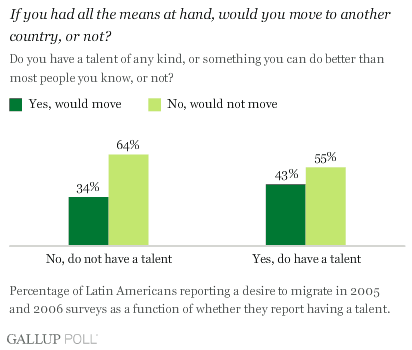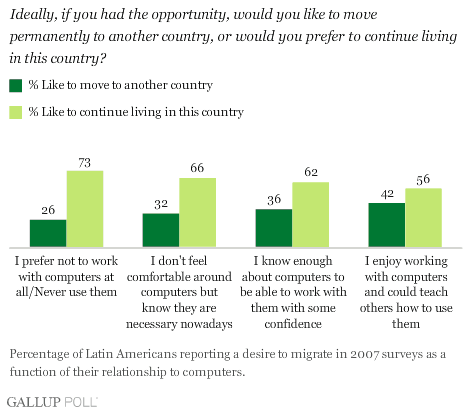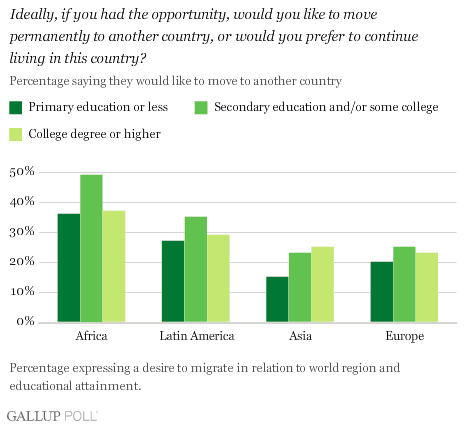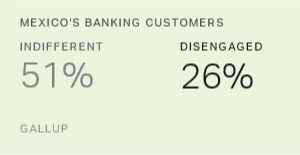WASHINGTON, D.C. -- Gallup Polls conducted in Latin America in 2005 and 2006 show that those who feel they have a talent few others share are more likely to report that they would like to migrate.

The tendency for the talented to wish to migrate seems to extend to those who possess marketable job skills. Specifically, Gallup Polls conducted in 2007 show that Latin Americans who report that they enjoy working with computers and could teach others how to use them are more likely to express a desire to migrate than are people who report being less familiar or comfortable with computers. Importantly, this tendency for those comfortable with computers to be more interested in migration held up among both young and old respondents, suggesting that computer skills are not simply a proxy for youth.

These findings -- that people who say they are more talented and more comfortable with computers are more likely to report a desire to migrate -- are consistent with recent worldwide Gallup Polls. These recent polls show that, in rich and poor countries worldwide, people with higher incomes are more likely to report that they would like to migrate. Taken together, such findings suggest that the problem of "brain drain" -- the loss of talented, knowledgeable, and skilled people -- many poorer Latin American countries face is not likely to end anytime soon.
Migration and Education
However, the 2007 and 2008 Gallup worldwide polls suggest that the relation between education and the desire to migrate is not as simple as the relation for talent, or for people's feelings about computers. Specifically, the polls show that the relation between education and the desire to migrate is curvilinear rather than linear, at least in Latin America and Africa. Relative to people with a primary education or less, both Africans and Latin Americans with a high school education are more likely to express a desire to migrate. However, in Africa and Latin America, those who possess a college degree or higher are (a) less likely to report a desire to migrate compared with high school graduates and (b) roughly as likely as those with very little education to report a desire to migrate. In Asia, the association between education and migration desire is linear. The most highly educated group is the most likely to report a desire to migrate. In Europe, the association is curvilinear but modest. To summarize, in every region examined except Asia, the association between education and migration desire is curvilinear. This is good news for Africa and Latin America because it suggests that there is a limit to brain drain. Whereas previous analyses showed that a nation's wealthiest residents are the most likely to report a desire to migrate, this is not always the case for a country's most educated residents.

Without knowing more about people's specific professions and the specific countries to which people wish to migrate, it is impossible to know for sure why this pattern is often curvilinear. It seems likely, though, that at least part of the reason for this curvilinear pattern could be that extremely well-educated migrants (e.g., medical doctors, attorneys) often face the prospect of reapplying for professional certification, or even reentering professional school, if they wish to practice their profession in a high GDP country. In the United States, for example, doctors who receive their degrees from a foreign medical school often face extensive testing before they can practice their profession. They may also be required to put in several years of supervised training. Thus, unlike money, talent, or computer skills, which travel well from country to country, professional licenses often lose their value at international borders. To the degree that such barriers are less severe in Asia than in the rest of the world, this may explain the linear effect of education in Asia. At any rate, this professional barrier for highly educated people who wish to migrate may represent a ray of hope to the citizens of less wealthy African or Latin American countries. Professional barriers to migration for the extremely well-educated may place a partial limit on brain drain.
Survey Methods
Results are based on telephone and face-to-face interviews conducted between 2006 and 2008 with approximately 1,000 adults per country outside Latin America and approximately 2,000 adults per country inside Latin America. For results in Latin America, as well as worldwide results, confidence intervals ranged between ±1 and ±4 percentage points depending on sample sizes. In addition to sampling error, question wording and practical difficulties in conducting surveys can introduce error or bias into the findings of public opinion polls.
